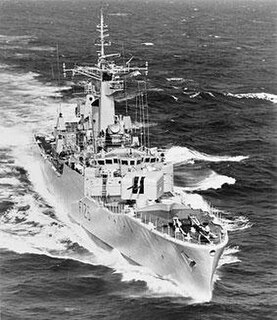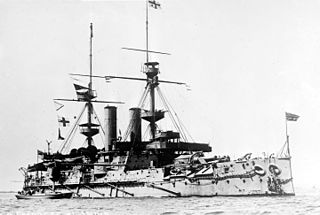
HMS Beagle was a Cherokee-class 10-gun brig-sloop of the Royal Navy, one of more than 100 ships of this class. The vessel, constructed at a cost of £7,803, was launched on 11 May 1820 from the Woolwich Dockyard on the River Thames. Later reports say the ship took part in celebrations of the coronation of King George IV of the United Kingdom, passing through the old London Bridge, and was the first rigged man-of-war afloat upriver of the bridge. There was no immediate need for Beagle so she "lay in ordinary", moored afloat but without masts or rigging. She was then adapted as a survey barque and took part in three survey expeditions.

Admiral Sir James Stirling was a Scottish naval officer and colonial administrator. His enthusiasm and persistence persuaded the British Government to establish the Swan River Colony and he became the first Governor and Commander-in-Chief of Western Australia. In 1854, when Commander-in-Chief, East Indies and China Station, Stirling on his own initiative signed Britain's first Anglo-Japanese Friendship Treaty. Throughout his career Stirling showed considerable diplomatic skill and was selected for a number of sensitive missions. Paradoxically, this was not reflected in his personal dealings with officialdom and his hopes for preferment received many rebuffs. Stirling also personally led the attack in Western Australia on a group of approximately seventy Bindjareb men, women and children now known as the Pinjarra massacre.

HMS Plymouth was a Royal Navy Rothesay-class frigate. In 1982, Plymouth was one of the first Royal Navy ships to arrive in the South Atlantic during the Falklands War.

HMS Royal Sovereign was a 100-gun first-rate ship of the line of the Royal Navy, which served as the flagship of Admiral Collingwood at the Battle of Trafalgar. She was the third of seven Royal Navy ships to bear the name. She was launched at Plymouth Dockyard on 11 September 1786, at a cost of £67,458, and was the only ship built to her dsign. Due to the high number of Northumbrians on board the crew were known as the Tars of the Tyne.

HMS Hecla was a Royal Navy Hecla-class bomb vessel launched in 1815. Like many other bomb vessels, she was named for a volcano, in this case Hekla in southern Iceland. She served at the Bombardment of Algiers in 1816. Subsequently she took part in three expeditions to the Arctic. She then served as a survey vessel on the coast of West Africa until she was sold in 1831. She became a merchantman and in 1834 a Greenland whaler. She was wrecked in 1840.

Admiral John Lort Stokes, RN was an officer in the Royal Navy who travelled on HMS Beagle for close to eighteen years.

Francis Price Blackwood was a British naval officer who while posted at several different locations during his time in the Royal Navy, spent much of his time posted in colonial Australia and was an instrumental pioneer of regions near Australia's east coast and nearby islands.

Joseph Beete Jukes, born to John and Sophia Jukes at Summer Hill, Birmingham, England, was a renowned geologist, author of several geological manuals and served as a naturalist on the expeditions of HMS Fly. Correspondents and friends addressed him as Beete Jukes.

HMS Warspite was a 74-gun third-rate ship of the line of the Royal Navy, launched in 1807. She served in the Napoleonic Wars and was decommissioned in 1815. After conversion to a 76-gun ship in 1817 she circumnavigated the world, visiting Australia. She was cut down to a single decker 50-gun frigate in 1840 and was decommissioned in 1846. She was lent as a boys' training ship to The Marine Society and was lost to fire in 1876.

HMS Superb was a 80-gun second rate Vanguard-class ship of the line built for the Royal Navy in the 1840s. She was broken up in 1869.

HMS Empress of India was one of seven Royal Sovereign-class pre-dreadnought battleships built for the Royal Navy during the 1890s. The ship was commissioned in 1893 and served as the flagship of the second-in-command of the Channel Fleet for two years. She was transferred to the Mediterranean Fleet in 1897, during which time Empress of India was assigned to the International Squadron blockading Crete during the uprising there. She returned home in 1901 and was briefly assigned as a coast guard ship in Ireland before she became the second flagship of the Home Fleet. The ship was reduced to reserve in 1905 and accidentally collided with the submarine HMS A10 the following year. Empress of India was taken out of service in early 1912 and accidentally struck a German sailing ship while under tow. She was sunk as a target ship in 1913.

HMS Actaeon was a 26-gun sixth-rate frigate of the Royal Navy.

HMS Geyser was a Driver-class wooden paddle sloop of the Royal Navy constructed in 1841 and broken up in 1866.

HMS Alert was a 17-gun wooden screw sloop of the Cruizer class of the Royal Navy, launched in 1856 and broken up in 1894. She was the eleventh ship of the Royal Navy to bear the name, and was noted for her Arctic exploration work; in 1876 she reached a record latitude of 82° North. Alert briefly served with the US Navy, and ended her career with the Canadian Marine Service as a lighthouse tender and buoy ship.

Wreck Island is a small coral cay. It is located near the Tropic of Capricorn in the southern Great Barrier Reef, 93 km due north east of Gladstone, Queensland, Australia, and 460 km north of the state capital Brisbane.

HMS Salamander was one of the initial steam powered vessels built for the Royal Navy. On 10 January 1831 the First Sea Lord gave orders that four paddle vessels be built to competitive designs. The vessels were to be powered by Maudslay, Son & Field steam engines, carry a schooner rig and mount one or two 10-inch shell guns. Initially classed simply as a steam vessel (SV), she was re-classed as a second-class steam sloop when that categorization was introduced on 31 May 1844. Designed by Joseph Seaton, the Master Shipwright of Sheerness, she was initially slated to be built in Portsmouth, and was changed to Sheerness Dockyard. She was launched and completed in 1832, took part in the Second Anglo-Burmese War and was broken up in 1883.

HMS Winchester was a 60-gun Southampton-class sailing frigate of the Royal Navy. She was laid down in 1816 at Woolwich Dockyard, and launched on 21 June 1822. Although designed for 60 guns, she and the rest of the class carried 52 guns. From 1831 to 1861 she served in North America and Southeast Asia. In 1861 she became the training ship Conway at Liverpool, and from 1876 she was the training ship Mount Edgcumbe. She was sold in 1921.

HMS Imogene was a Conway-class sixth rate of the Royal Navy, built by Pembroke Dockyard and launched on 24 June 1831. She served in the East Indies, China and South America, but was accidentally burnt while out of commission on 27 September 1840.

HMS Harrier was an 18-gun Fly-class sloop, built for the Royal Navy during the 1830s.

Harden Sidney Melville (1824–1894) was an English painter, illustrator and draughtsman. He received a medal from the Society of Arts and had three paintings hung in the Royal Academy’s show between 1837 and 1841. He conducted the first official hydrographic survey of the north-east coast of Australia in 1842–1846 on board the H.M.S Fly, which was under the command of Captain Francis Price Blackwood. He illustrated Curiosities of Savage Life by James Greenwood and several notable Australian works including Joseph Beete Jukes’s official narrative of Fly’s voyage and Ludwig Leichhardt’s Journal.





















